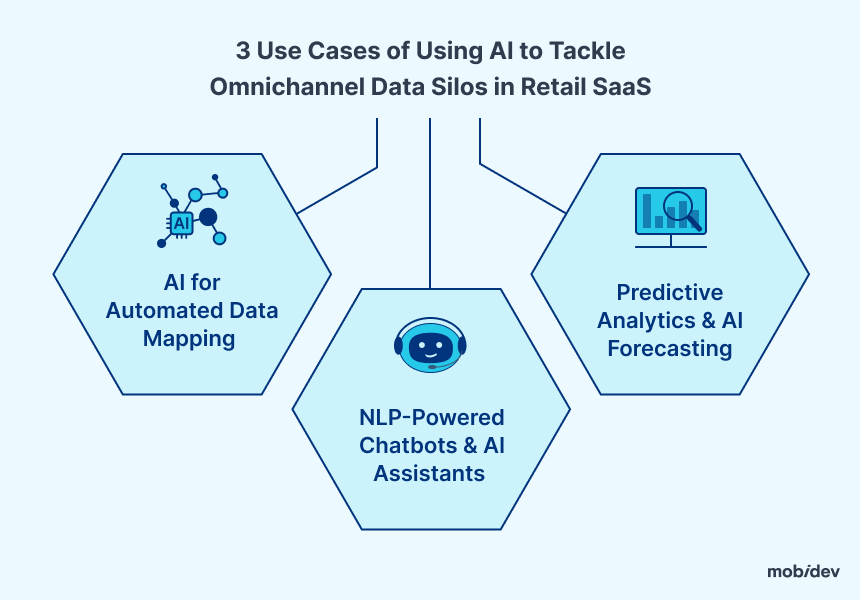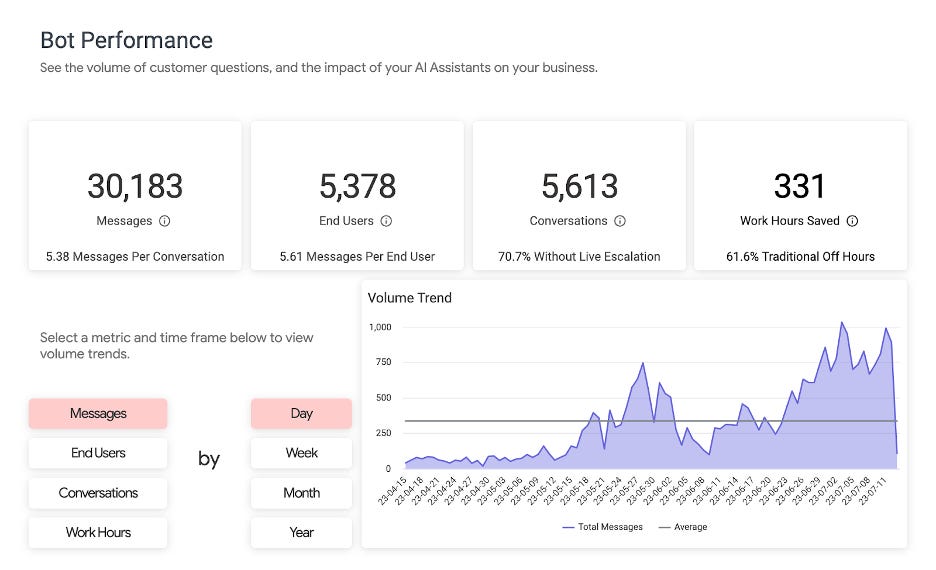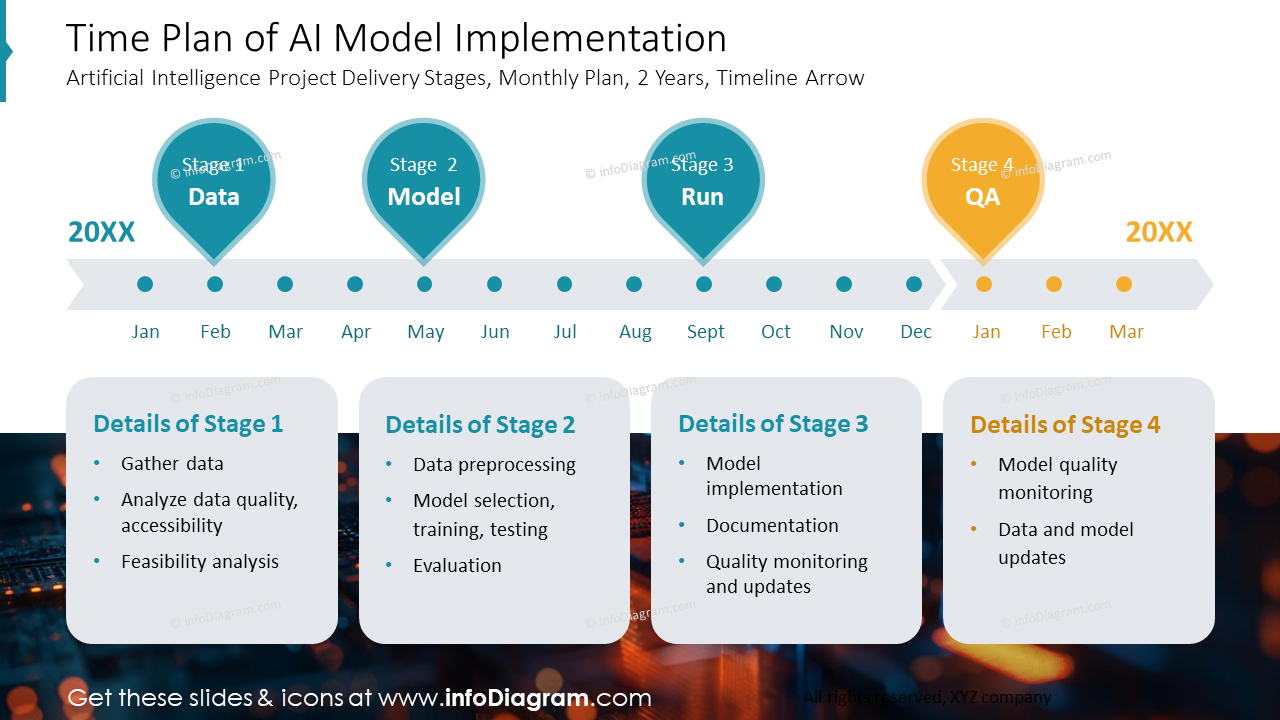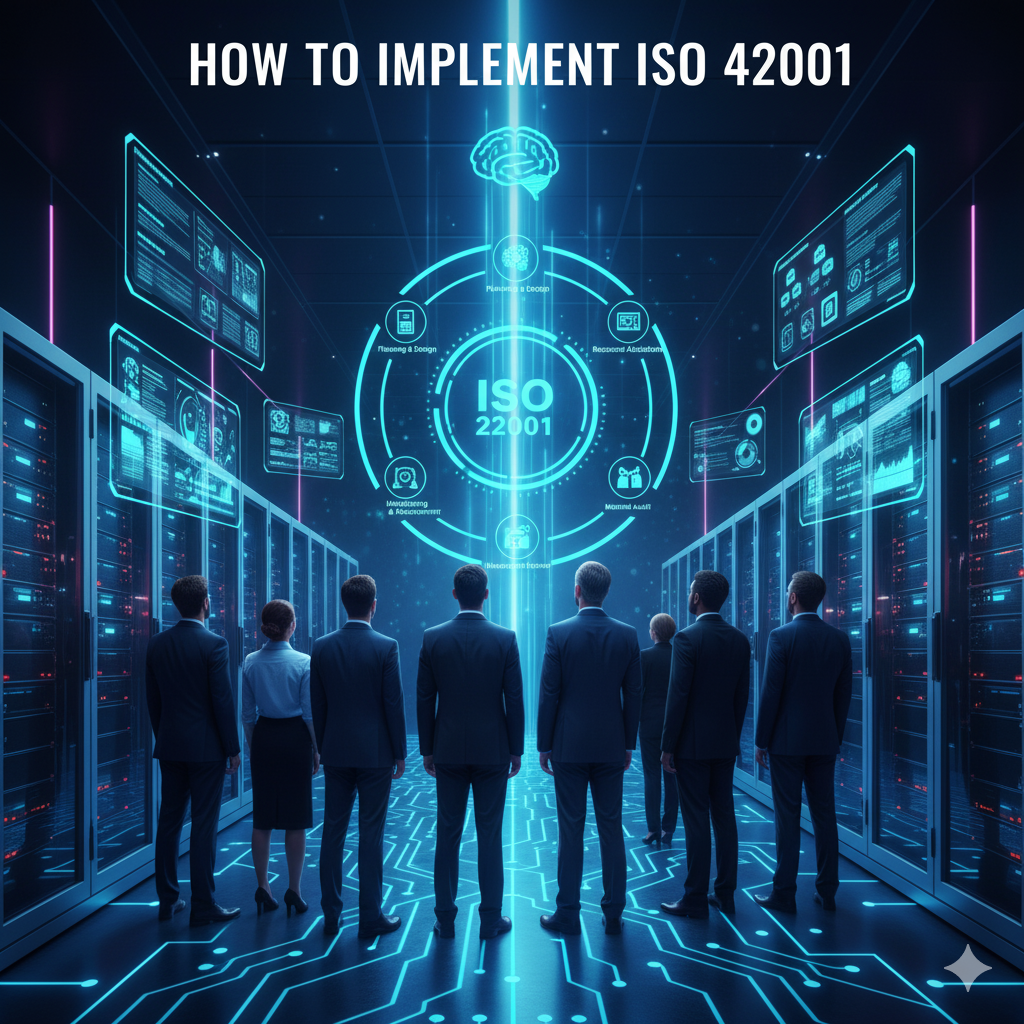Artificial intelligence transforms customer experience by automating interactions, personalizing services, and predicting customer needs across all business sectors.
Customer service has shifted from reactive problem-solving to predictive assistance that anticipates issues before customers encounter them. Companies now use AI systems that learn from millions of interactions to provide instant, accurate responses at any hour. These systems analyze customer behavior patterns to deliver personalized recommendations and solutions.
The technology enables businesses to serve customers consistently across phone calls, websites, mobile apps, and physical locations. AI processes natural language to understand customer intent and sentiment in real-time. Organizations can now scale personalized service to millions of customers simultaneously without proportional increases in staff.

Source: Emitrr
What Is AI Customer Experience
AI customer experience refers to using artificial intelligence technology to analyze customer data and create personalized interactions between businesses and their customers. This technology processes information from customer purchases, website visits, support conversations, and other touchpoints to understand individual preferences and behaviors.
The core shift involves moving from reactive approaches to proactive ones. Traditional customer service waits for customers to report problems before responding. AI-powered systems predict customer needs and address potential issues before they become problems.
AI customer experience technology includes chatbots that understand natural language, recommendation engines that suggest relevant products, and predictive analytics that identify when customers might need help. These systems operate across websites, mobile apps, phone calls, and in-person interactions to create consistent experiences.
Organizations implementing AI customer experience systems report measurable improvements in customer satisfaction and operational efficiency. The technology handles routine inquiries automatically while directing complex situations to human agents who have access to complete customer context.
How AI Transforms Customer Interactions
Personalization at Scale
Machine learning algorithms analyze vast amounts of customer data to identify behavior patterns and preferences that humans cannot detect manually. These algorithms process information from purchase history, browsing behavior, social media activity, and demographic data to create detailed customer profiles.

Source: ResearchGate
The system then uses these profiles to deliver individualized experiences to millions of customers simultaneously. Machine learning models continuously learn from new customer interactions and adjust their recommendations in real-time.
Examples of personalization include:
- Product recommendations — E-commerce platforms suggest items based on past purchases and browsing history
- Content customization — Streaming services display different movie selections for each user based on viewing preferences
- Email personalization — Marketing messages include specific product suggestions tailored to individual customer segments
- Communication timing — Systems send messages when individual customers are most likely to open and engage with them
Predictive Customer Service
Predictive analytics uses historical data and machine learning models to forecast when customers will likely experience problems or need assistance. The system analyzes patterns in customer behavior, product usage, and past service interactions to identify potential issues before customers become aware of them.

Source: ResearchGate
AI systems monitor multiple data sources including product sensors, usage logs, transaction records, and customer communication patterns. When algorithms detect anomalies or patterns that historically lead to problems, they trigger automated responses or alert service teams.
Smart appliances detect when components show signs of wear and automatically schedule service appointments before breakdowns occur. Banks contact customers when spending patterns indicate potential fraud or when account balances suggest upcoming overdraft fees.
Conversational AI and Automated Interactions
Conversational AI encompasses chatbots, virtual assistants, and voice-activated systems that communicate with customers using natural language processing. These systems understand customer inquiries, interpret intent, and provide relevant responses without human intervention.
Modern conversational AI can handle complex multi-turn conversations and maintain context throughout interactions. AI agents handle routine inquiries like account balances and order status. Virtual assistants perform more complex tasks including appointment scheduling and multi-step problem resolution.
Voice AI systems enable hands-free interactions through smart speakers, phone systems, and mobile applications. The technology provides instant responses twenty-four hours a day with consistent quality across all interactions.
AI Technologies Changing Customer Experience
Natural Language Processing
Natural Language Processing enables computers to understand, interpret, and respond to human language in ways that feel natural to customers. NLP systems analyze the words customers use and determine what they actually mean, going beyond simple keyword matching to understand context and intent.
Source: LinkedIn
Sentiment analysis represents a key component of NLP that identifies emotions in customer communications. When a customer writes “I’m frustrated with this product,” sentiment analysis recognizes the negative emotion and can route the inquiry to a specialized team.
Modern NLP systems understand context across entire conversations, remembering what customers discussed earlier and maintaining coherent dialogue threads. These systems interpret slang, abbreviations, and industry-specific terminology while adapting their communication style to match individual customer preferences.
Machine Learning and Predictive Analytics
Machine learning algorithms analyze patterns in customer data to predict future behaviors and preferences. These systems examine purchase history, browsing patterns, and interaction data to identify trends that humans might miss.
Recommendation engines use machine learning to suggest products or services based on customer behavior and preferences. The algorithms compare individual customers to others with similar characteristics and recommend items that comparable customers purchased.
Churn prevention systems analyze customer engagement patterns to identify individuals likely to stop using a service or product. Machine learning models examine factors like decreased usage, support ticket frequency, and payment patterns to predict which customers might leave.
Organizations use these predictive capabilities to personalize customer experiences, optimize inventory management, and improve service delivery timing. Machine learning systems become more accurate over time as they process additional customer interactions.
Computer Vision Applications
Computer vision technology enables machines to interpret and analyze visual information from images and videos. In customer experience applications, computer vision systems can identify products, read text, and recognize visual patterns that help customers find what they need.
Visual search applications allow customers to upload photos to find similar products or get information about items they see. Product recognition systems can identify items in customer photos and provide relevant information, pricing, or troubleshooting guidance.
Insurance companies use computer vision to assess damage from photos customers submit, speeding up claim processing. Augmented reality applications combine computer vision with digital overlays to help customers visualize products in their environment before purchasing.
Industry Applications of AI Customer Experience
Healthcare Patient Experience
Healthcare organizations use AI to streamline patient interactions and improve care coordination across multiple touchpoints. AI-powered appointment scheduling systems analyze provider availability, patient preferences, and medical urgency to optimize scheduling and reduce wait times.
Virtual health assistants handle routine patient inquiries around the clock, answering questions about medications, test results, and appointment preparation. These systems integrate with electronic health records to provide personalized responses based on individual patient histories.
Care coordination platforms use AI to track patient progress across different providers and specialties. The systems identify care gaps, schedule follow-up appointments automatically, and send personalized reminders for medications and preventive care.
Healthcare AI implementations require strict privacy protections under HIPAA regulations. Organizations implement data encryption, access controls, and audit trails to protect patient information while ensuring AI systems undergo clinical validation before deployment.
Financial Services Personalization
Financial institutions deploy AI to create personalized banking experiences that adapt to individual customer needs and financial goals. AI-driven financial advisors analyze spending patterns, investment histories, and life events to provide customized recommendations.
Fraud detection systems use machine learning to identify unusual transaction patterns in real-time. These systems analyze factors including transaction amounts, locations, merchant types, and timing to flag potentially fraudulent activities while minimizing false positives.
Personalized banking applications provide customized financial insights, budget recommendations, and spending alerts based on individual customer behavior. Wealth management platforms use AI to create personalized investment portfolios based on risk tolerance and market conditions.
Retail Omnichannel Experiences
Omnichannel experiences integrate AI across online, mobile, and physical store interactions to create seamless customer journeys. AI systems track customer preferences and behaviors across all touchpoints to maintain consistency regardless of interaction channel.

Source: MobiDev
Cross-channel personalization includes:
- Product recommendations — Sync across website visits, mobile app usage, and in-store browsing history
- Dynamic pricing — Adjusts based on customer segments, inventory levels, and competitive pricing data
- Inventory optimization — Predicts demand patterns and ensures product availability across all channels
- Virtual shopping assistants — Maintain conversation history across devices and platforms
AI-powered customer service chatbots handle routine inquiries while seamlessly transferring complex issues to human representatives. These systems maintain context throughout interactions, ensuring customers don’t repeat information when transferred between channels.
Manufacturing B2B Support
Manufacturing and enterprise technology companies use AI to provide sophisticated technical support for complex products and systems. AI-powered knowledge bases analyze technical documentation, troubleshooting guides, and previous support cases to provide instant answers to technical questions.
Customer onboarding systems use AI to create personalized training programs based on customer industry, system configuration, and user roles. These platforms adapt content delivery based on learning progress and identify areas where customers need additional support.
Technical support chatbots handle initial troubleshooting for common issues, walking customers through diagnostic procedures and solution steps. When issues require human intervention, AI systems provide technicians with comprehensive case histories and suggested solutions.
Predictive maintenance communications use AI to analyze equipment data and notify customers about potential issues before failures occur. These systems coordinate maintenance scheduling, parts ordering, and service appointments to minimize equipment downtime.
Benefits of AI Customer Experience

Source: The Father Gap – Substack
Operational Efficiency
AI automation transforms customer service operations by handling routine inquiries, processing requests, and routing complex issues to appropriate human agents. Customer service teams spend less time on repetitive tasks like password resets and order status checks when AI systems manage these interactions automatically.
Resource optimization occurs when AI systems analyze customer inquiry patterns and adjust staffing recommendations accordingly. Organizations can allocate human agents to high-value activities that require empathy and complex problem-solving while AI handles standard procedures.
Process improvements emerge as AI systems eliminate manual handoffs between departments and reduce response times for common customer requests. Consistency increases across all customer interactions because AI systems follow standardized protocols.
Enhanced Customer Satisfaction
Customer satisfaction improves when AI provides immediate responses to inquiries and maintains context throughout extended conversations. Customers receive consistent service quality whether they contact support at midnight or during peak business hours.
Personalization drives loyalty by enabling AI systems to recognize individual customer preferences, purchase history, and communication styles. Customers feel understood when AI remembers their previous interactions and tailors responses to their specific situations.
Net Promoter Score improvements result from faster resolution times and more accurate information delivery. Customer retention increases when AI systems proactively identify potential issues and address them before customers experience problems.
Revenue Growth Through Personalization
Personalized experiences drive business outcomes by presenting relevant products and services at optimal moments in the customer journey. AI analyzes customer behavior patterns to recommend items that align with individual preferences and purchasing habits.
Conversion rates improve when AI systems guide customers through purchase decisions by providing personalized assistance and addressing specific concerns. Sales teams can use upselling opportunities that emerge naturally when AI identifies complementary products or service upgrades that genuinely benefit individual customers.
Customer lifetime value increases as AI systems foster long-term relationships through personalized engagement that evolves with changing customer preferences and life circumstances.
Implementation Challenges
Data Privacy and Security
AI customer experience systems require access to extensive customer information to function effectively, creating significant data protection responsibilities for organizations. Customer data includes personal identifiers, transaction histories, communication records, and behavioral patterns.

Source: LeewayHertz
The General Data Protection Regulation applies to organizations processing personal data of European Union residents, requiring explicit consent for data collection and clear communication about data usage. The California Consumer Privacy Act provides similar protections for California residents.
Organizations face additional compliance requirements under various state and international privacy laws that mandate specific data handling procedures. Privacy regulations typically require organizations to implement data minimization practices, limiting collection to information necessary for stated purposes.
Data security measures for AI customer experience systems include encryption of stored and transmitted data, access controls that limit system access to authorized personnel, and audit logging that tracks data usage and system interactions.
Integration Complexity
AI customer experience implementations face complex integration challenges when connecting with existing customer relationship management systems, transaction processing platforms, and communication infrastructure. Legacy systems often use outdated data formats and communication protocols that require significant modification.
System integration projects typically involve developing application programming interfaces that enable data exchange between AI platforms and existing business systems. Organizations must design integration architectures that maintain system performance while enabling AI access to necessary customer data.
Data migration challenges arise when transferring customer information from legacy systems to AI platforms, particularly when data formats or quality standards differ between systems. Migration projects require data cleansing, standardization, and validation processes.
Legacy system compatibility considerations include hardware limitations, software version constraints, and architectural differences that may prevent direct integration with modern AI platforms. Some organizations implement middleware solutions that translate data between legacy systems and AI applications.
Workforce Transformation
Employee adaptation to AI tools requires comprehensive training programs that address both technical skills and changing job responsibilities as AI systems handle routine customer service tasks. Customer service representatives must learn to work alongside AI systems.
Training programs typically cover AI system operation, interpretation of AI-generated insights, and escalation procedures for situations requiring human intervention. Employees need skills in managing AI-assisted conversations and providing empathetic customer support.
Role evolution occurs as AI systems assume responsibility for routine inquiries, data entry, and standard problem resolution, allowing human agents to focus on complex customer issues and relationship building. Customer service roles often expand to include AI system monitoring and quality assurance.
Human-AI collaboration models define how employees and AI systems share responsibilities for customer service delivery. AI change management requires clear protocols for when AI systems handle customer interactions independently and when human oversight is required.
Future Trends in AI Customer Experience
Agentic AI Systems
Agentic AI refers to artificial intelligence systems that can think through problems, make decisions, and take actions without constant human supervision. These AI agents operate like digital employees who can understand complex situations and solve problems from start to finish.
Current chatbots respond to specific prompts and follow predetermined scripts. Agentic AI systems reason through problems, remember previous conversations, and use multiple tools to complete tasks. An agentic AI customer service system might investigate a billing error, identify the problem source, process a refund, and send a follow-up email explaining the resolution.
These systems combine natural language understanding, reasoning abilities, memory to track conversation context, and decision-making frameworks. The AI agents can collaborate with other specialized agents and escalate complex issues to human representatives when situations require emotional intelligence.
Multimodal Interactions
Multimodal AI processes and responds to multiple types of input simultaneously, including text, speech, images, and gestures. Instead of limiting interactions to typing or speaking, customers can communicate through combinations of voice commands, uploaded photos, and screen sharing.

Source: SmartDev
A multimodal customer service system might allow a customer to take a photo of a broken product, describe the problem verbally, and point to specific damage areas on their screen. The AI analyzes the visual information, processes the spoken description, and understands gesture-based indicators.
Voice technology integration enables more natural conversations through advanced speech recognition and generation capabilities. Natural language interfaces process conversational requests rather than requiring specific commands or menu navigation.
Predictive Customer Models
Predictive customer experience models use data analysis to anticipate customer needs before customers recognize those needs themselves. These systems analyze patterns in customer behavior, purchase history, product usage, and external factors to forecast future requirements.
Preventive service delivery involves identifying and addressing issues before they impact customer experience. AI systems monitor product performance data, usage patterns, and environmental conditions to predict when equipment might fail or when customers might encounter difficulties.
Predictive analytics for customer behavior examines historical data and current activities to forecast future actions and preferences. The analysis considers seasonal patterns, life events, buying cycles, and interaction history to predict when customers might need specific products or services.
Frequently Asked Questions
How long does it take to see results from AI customer experience implementation?
AI customer experience investments typically show returns in three distinct phases. Organizations often see quick wins within three to six months through improved response times and reduced routine inquiry volume. Basic automation can decrease customer service costs by twenty to thirty percent during this initial period.

Source: infoDiagram
The intermediate phase occurs between six to eighteen months as AI systems learn from customer interactions and improve accuracy. Organizations report measurable improvements in customer satisfaction scores and operational efficiency during this period as personalization engines and predictive service capabilities begin generating value.
Long-term returns materialize after eighteen to twenty-four months when AI systems achieve full integration and optimization. The compound benefits include reduced customer churn, increased customer lifetime value, and significant operational cost savings that can reach forty to fifty percent for routine service interactions.
Which AI customer experience platform works best for healthcare organizations?
Healthcare organizations require AI platforms with specific compliance and safety features that address industry regulations and patient protection requirements. Platforms must include HIPAA compliance capabilities, patient safety features, and integration with electronic health record systems.
Key evaluation criteria for healthcare AI platforms include secure data handling, audit trails for patient interactions, clinical validation capabilities, and integration with medical terminology databases. Healthcare platforms also need features for appointment scheduling, medication management, and care coordination across multiple providers.
Organizations should evaluate platforms based on their track record in healthcare implementations, ongoing support for regulatory compliance, and ability to integrate with existing healthcare technology infrastructure. Pilot testing with real patient scenarios helps determine which platform best handles healthcare-specific requirements.
How do financial institutions ensure AI customer service complies with banking regulations?
Financial institutions must address multiple regulatory requirements when implementing AI customer service systems. The NIST AI Risk Management Framework provides voluntary guidelines for incorporating trustworthiness into AI system design and operation across all industries.
Banking-specific regulations include fairness in lending decisions, transparency in algorithmic recommendations, and data protection under regulations like GDPR and state privacy laws. Financial institutions must also consider emerging regulations that mandate disclosure of AI use in customer interactions.
Compliance strategies require ongoing monitoring of regulatory developments and implementation of governance frameworks that ensure responsible AI use throughout the system lifecycle. Organizations typically establish AI ethics committees, implement bias testing procedures, and maintain detailed documentation of AI decision-making processes to demonstrate regulatory compliance.
What specific metrics indicate successful AI customer experience implementation?
Successful AI customer experience implementation can be measured through customer satisfaction scores, Net Promoter Scores, first-contact resolution rates, and average response times that provide measurable indicators of system impact on customer experience quality. These metrics enable organizations to compare AI performance against traditional customer service approaches.
Operational metrics include cost per interaction, agent productivity improvements, system uptime and reliability, and accuracy rates for AI responses that demonstrate business value and technical performance. Organizations also track customer adoption rates for AI-powered service channels and analyze customer preferences for AI versus human assistance.
Qualitative indicators include customer feedback analysis, sentiment trends in customer communications, and employee satisfaction scores that provide insight into the human impact of AI implementation. These measurements help organizations understand whether AI systems enhance or detract from personal aspects of customer relationships that drive long-term loyalty.
How can small businesses implement AI customer experience without large technology budgets?
Small businesses can start with cloud-based AI customer experience platforms that offer subscription pricing models rather than requiring large upfront investments. Many platforms provide basic chatbot functionality, email automation, and customer analytics for monthly fees that scale with business size.
Initial implementations can focus on high-impact, low-complexity use cases such as FAQ chatbots, automated email responses, and basic customer inquiry routing. These solutions handle routine customer service tasks while freeing staff to focus on complex customer relationships and business development activities.
Small businesses benefit from platforms that offer pre-built industry templates, easy integration with existing websites and communication tools, and minimal technical setup requirements. Many AI customer experience vendors offer free trials or starter plans that allow small businesses to test functionality before committing to paid services.


